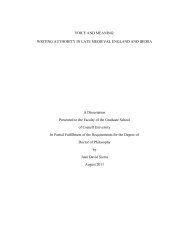Briana Anderson - Cornell University
Briana Anderson - Cornell University
Briana Anderson - Cornell University
You also want an ePaper? Increase the reach of your titles
YUMPU automatically turns print PDFs into web optimized ePapers that Google loves.
source credibility). Each person viewed two advertisements with two different<br />
companies, two very similar messages about involvement in breast cancer research<br />
and two different endorsers (one attractive, one unattractive). The company types<br />
used were a cosmetics company (called “Azure Cosmetics”) and a pharmaceutical<br />
company (called “Pharmco Pharmaceuticals”), where the cosmetics company<br />
23<br />
represents a beauty-related company and the pharmaceutical company a non-beauty-<br />
related company. There were four combinations of the endorsers and companies (see<br />
Table 1 below). Additionally, public relations scholars have suggested that a CSR<br />
campaign or initiative should be connected to an organization’s brand or identity<br />
(Daugherty, 2001), so a pharmaceutical and cosmetics company were chosen because<br />
both types of companies are related to breast cancer research (one with a woman focus<br />
and the other with a focus on medical research).<br />
Table 1<br />
Research Design<br />
Azure Cosmetics Pharmco<br />
Pharmaceuticals<br />
Attractive endorser 1 1 4<br />
Attractive endorser 2<br />
Unattractive endorser 3<br />
Unattractive endorser 4<br />
3 2<br />
2 1<br />
4 3<br />
The messages (as would appear in a magazine or website) stated the<br />
company’s involvement in a social responsibility activity, i.e. breast cancer research,<br />
and were accompanied by a headshot picture of the company’s Human Resources

















